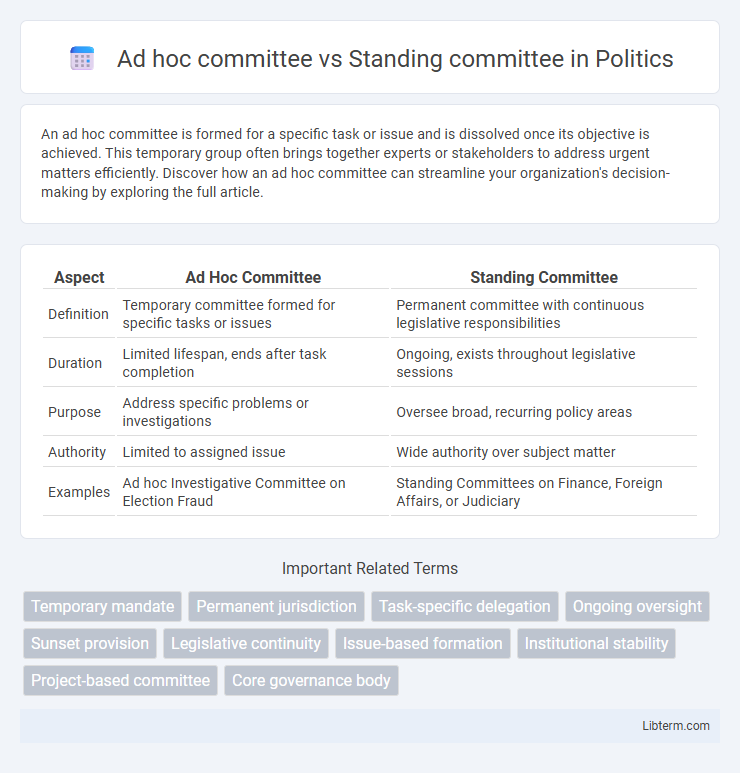An ad hoc committee is formed for a specific task or issue and is dissolved once its objective is achieved. This temporary group often brings together experts or stakeholders to address urgent matters efficiently. Discover how an ad hoc committee can streamline your organization's decision-making by exploring the full article.
Table of Comparison
| Aspect | Ad Hoc Committee | Standing Committee |
|---|---|---|
| Definition | Temporary committee formed for specific tasks or issues | Permanent committee with continuous legislative responsibilities |
| Duration | Limited lifespan, ends after task completion | Ongoing, exists throughout legislative sessions |
| Purpose | Address specific problems or investigations | Oversee broad, recurring policy areas |
| Authority | Limited to assigned issue | Wide authority over subject matter |
| Examples | Ad hoc Investigative Committee on Election Fraud | Standing Committees on Finance, Foreign Affairs, or Judiciary |
Introduction to Ad Hoc and Standing Committees
Ad hoc committees are temporary groups established to address specific tasks or issues, disbanding once their objectives are achieved. Standing committees are permanent bodies within an organization or legislature, responsible for ongoing oversight and specialized functions. Both committees play crucial roles in efficient decision-making and governance, with ad hoc committees offering flexibility and standing committees providing continuity.
Definition of Ad Hoc Committee
An Ad Hoc Committee is a temporary group formed to address a specific issue or task, dissolved once its purpose is fulfilled. Unlike standing committees, which are permanent and handle ongoing responsibilities, ad hoc committees provide focused, specialized attention to unique or urgent matters. Organizations rely on ad hoc committees to offer timely solutions without altering the structure of existing standing committees.
Definition of Standing Committee
A standing committee is a permanent legislative panel established to handle specific areas of policy or government function, such as finance or education, ensuring continuous oversight and detailed examination of related issues. In contrast, an ad hoc committee is temporary and created to address a specific task or investigation, disbanding once its objective is achieved. Standing committees play a crucial role in the legislative process by reviewing bills, conducting hearings, and monitoring government operations on an ongoing basis.
Key Differences Between Ad Hoc and Standing Committees
Ad hoc committees are temporary groups formed for a specific task or issue, disbanding after their objective is achieved, while standing committees are permanent entities handling ongoing responsibilities within an organization or legislature. Standing committees maintain continuous oversight and develop expertise in particular areas such as finance or health, whereas ad hoc committees address emergent or specialized matters requiring focused attention. The structured permanence of standing committees enables consistent policy review, contrasting with the flexible, issue-specific nature of ad hoc committees.
Formation Processes of Committees
Ad hoc committees are formed temporarily to address specific issues or tasks, with members appointed based on relevant expertise or representation needs, and disbanded after completing their assignments. Standing committees are established as permanent bodies within an organization or legislature, with members selected through formal procedures such as elections or appointments, maintaining ongoing jurisdiction over particular policy areas or functions. The formation process of ad hoc committees emphasizes flexibility and responsiveness, while standing committees rely on structured, consistent membership to ensure continuity and institutional knowledge.
Duration and Lifespan of Each Committee Type
Ad hoc committees are temporary, created for a specific task or issue and dissolved after achieving their objective, making their lifespan short and clearly defined. Standing committees, conversely, are permanent bodies established to address ongoing responsibilities and legislative areas, functioning continuously across multiple sessions. The duration of standing committees allows sustained oversight and consistent policy development, unlike the fixed-term nature of ad hoc committees.
Roles and Responsibilities
Ad hoc committees are temporary groups established to address specific issues or tasks, often dissolving after completing their assigned objectives, whereas standing committees are permanent entities with ongoing responsibilities within an organization or legislative body. Standing committees review legislation, oversee relevant departments, and ensure continuity in policy-making, while ad hoc committees focus on specialized investigations, project planning, or problem-solving requiring timely intervention. The distinct roles and responsibilities of these committees enhance organizational efficiency by balancing long-term oversight with flexible, goal-oriented task management.
Advantages of Ad Hoc Committees
Ad hoc committees offer flexibility and specialization by addressing specific issues or tasks that arise temporarily, allowing for focused expertise and faster decision-making. Their temporary nature prevents bureaucratic delays common in standing committees, enhancing efficiency. Ad hoc committees also enable organizations to adapt quickly to emerging challenges without permanently expanding the committee structure.
Benefits of Standing Committees
Standing committees provide continuous oversight on specific policy areas, enabling members to develop specialized expertise and ensure consistent legislative review. Their permanent nature allows for thorough examination of bills, long-term policy development, and accountability in government operations. These committees facilitate efficient handling of complex issues by maintaining institutional memory and fostering stable working relationships among legislators.
Conclusion: Choosing the Right Committee Structure
Selecting the appropriate committee structure hinges on the organization's needs and objectives; ad hoc committees offer targeted solutions for specific issues with temporary mandates, while standing committees provide ongoing governance and consistent oversight in key organizational areas. Evaluating factors such as the scope of work, duration, and required expertise ensures efficient decision-making and resource allocation. A balanced approach leveraging both structures can maximize operational effectiveness and adaptability.
Ad hoc committee Infographic

 libterm.com
libterm.com